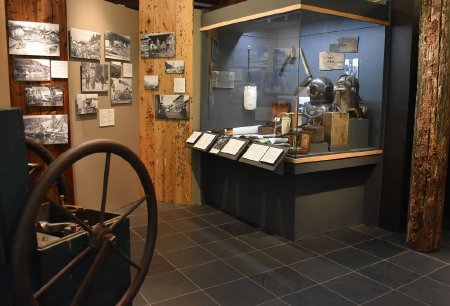Ketchikan is... Can't Escape the Land
Here we have to work with the land and the water. We live in a flooded mountain range. Because changing this isn't an option, residents have created and adopted tools to work with the landscape. The adze and the froe work cedar into house panels and shingles. Charts allow for navigation of fast-moving and difficult waterways. The sailor's ditty bag is a toolkit for fixing and making while onboard. Dive helmets give us entry into the majority of Southeast Alaska: the world of underwater. Compasses and surveying equipment bring an understanding of the land.
Originally, the city of Ketchikan was a handful of buildings atop tide flats near the Native fish camp at the mouth of the creek. A landscape of cliff, rock, and water necessitated that the expanding city develop a creative approach to building. The solution was to utilize the abundant and available trees. Early spruce mills, founded in 1892 (Tsimshian-owned on Gravina Island) and 1903 (built in downtown Ketchikan in today's Thomas Basin), quickly and efficiently set about transforming the forest into a whole town of pilings, wooden walkways, and streets. Even now, though most of our streets and sidewalks have been covered in concrete, the system of pilings is still holding us up.

